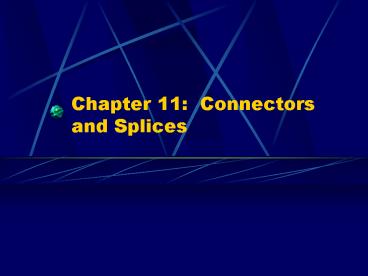Chapter 11: Connectors and Splices - PowerPoint PPT Presentation
1 / 19
Title:
Chapter 11: Connectors and Splices
Description:
Power through a length of fiber is measured. The fiber is cut in the center and a ... In single mode fiber with flat end faces, the loss amounts to -11 dB. ... – PowerPoint PPT presentation
Number of Views:1518
Avg rating:3.0/5.0
Title: Chapter 11: Connectors and Splices
1
Chapter 11 Connectors and Splices
2
Need for Connectors and Splices
- Fiber optic cables are made in limited lengths
- Typically 1 to 6 km
- Required at intermediate points between
transmitter and receiver - Entrance to buildings, wiring closets, etc.
- Fibers must be connected to the source in the
transmitter and the detector in the receiver - Fiber subsystems must be connected together
3
Connector Requirements
- Low loss
- Easy installation
- Repeatability connected and disconnected many
times - Consistency no variation in loss
- Economical
- General loss requirements
- 0.2 dB or less for telecom and long haul
- 0.3 to 0.75 dB for LANs and intrabuilding
- 1 to 3 dB for low-cost applications (plastic
fiber)
4
Causes of Loss in Interconnections
- Intrinsic or fiber-related
- Extrinsic or connector-related
- System factors
5
Intrinsic Loss Factors
- NA mismatch
- Core-diameter mismatch
- Cladding-diameter mismatch
- Concentricity
- Ellipticity
6
Extrinsic Loss Factors
End Separation
Lateral Displacement
Angular Misalignment
7
System Related Loss Factors
- Launch and receive conditions
- Short launch and short receive
- Short launch and long receive
- Long launch and short receive
- Long launch and long receive
- Conditions in fiber change until EMD
- Mode stripping in overfilled fibers at source
- Cladding modes will not couple into second fiber
and will be lost
8
Insertion Loss
- Method for specifying the performance of a
connector or splice - Power through a length of fiber is measured
- The fiber is cut in the center and a connector or
splice is applied - Power at the end of the fiber is again measured
- Insertion loss is
Where P2 is initial power measured and P1 is
power after connector is applied
9
Additional Losses
- When two different types of fiber are connected,
diameter- and NA-mismatch losses may be
significant
10
Additional Losses Example
- Transmitting fiber has a core diameter of 62.5
?m and an NA of 0.275 - Receiving fiber has a core diameter of 50 ?m and
an NA of 0.20
2
0.20
LossNA 10 log10
-2.8 dB
0.275
2
50
Lossdia 10 log10
-2.9 dB
62.5
11
Loss in Single Mode Fibers
- Small cores in single mode fibers require tighter
tolerances for connectors - A gap of 10 times the core diameter results in a
loss of 0.4 dB in a single mode fiber.
12
Return Reflection Loss
- When two fibers are separated by an air gap,
optical energy will be reflected back toward the
source. (Fresnel reflections) - In single mode fiber with flat end faces, the
loss amounts to -11 dB. - If 500 ?W is at the end of the fiber, about 40 ?W
is reflected back towards the source - Can cause instabilities in the laser diode source
- A rounded or angled polished fiber end can help
minimize the return loss.
13
Return Reflection Loss
14
Fiber Termination
- A connector or splice is used to terminate the
fiber. - Fusion splice is permanent and has very few parts
in the connection (if any at all) - Connectors use a ferrule to hold the fiber in
optical alignment. - Ceramic ferrules are best, stainless steel and
plastic are also used - Fibers are typically epoxied into the connector
- After the epoxy cures, the fiber end is polished
to a smooth end finish (rounded or angled)
15
Connector Examples
- FC-style Connector
- First one to use 2.5mm ceramic ferrule
- Uses a threaded coupling nut
- Has a tunable key
- Available in both single mode and multimode
versions.
16
Connector Examples
- ST-style connector
- Designed by ATT for premises wiring in buildings
and LANs - Uses same 2.5mm ceramic ferrule as FC
- Employs a quick release bayonet coupling
- Insertion loss is around 0.3 dB
- Most popular connector style
17
Connector Examples
- SC-style connector
- Name comes from subscriber connector (telecomm)
- Designed to be pull proof, ferrule is decoupled
from the cable and connector housing - Uses a push-pull engagement for mating (snaps
into socket) - Can easily be configured into multiple fiber
connectors
18
Splices
- Fusion Splice permanent solution
- Uses an electric arc to weld two fibers together
- Computer controlled alignment of fibers
- Losses on the order of 0.05 dB
- Virtually eliminate return reflections
- Mechanical Splice
- Easily applied in the field
- Losses on the order of 0.1 to 0.2 dB
- Can be reenterable (reused)
19
Fiber Preparation
- End face of fiber should be square to the fiber
but 1? to 2 ? off the perpendicular is OK - End face of fiber should have smooth mirror like
finish - Fiber is cleaved using scribe-and-break method
- End face polishing is accomplished after the
fiber is connectorized. - Polishing is done is several steps with
repeatedly finer polishing grits. (down to 1 ?m
or 0.3 ?m)

